Even before the current COVID-19 situation hit us, the rise of the digital era has brought about a significant change in the way modern education is imparted. Students and institutions across the world are not depending on the archaic, uni-dimensional methods of traditional learning anymore. Instead, they have started exploring a plethora of innovative online learning options, like online learning courses that harbor the potential to create competencies, increase engagement, and contextualize knowledge.
So much so, that almost 65% of educational institutions in the US alone have begun to support state-of-the-art online learning courses regularly! The number has gone significantly higher ever since the pandemic has spread across campuses and communities around the world. Here’s how educational institutions can maintain instructional continuity in times of crisis.
However, the growth of e-learning has also led to several questions about the method’s resource efficiency and cost-effectiveness. Institutions and students have both started weighing the impact of these online learning techniques, against the tried and tested more conventional learning methodologies.
This has created a great interest in understanding the comparative benefits of such courses, especially from an educational, developmental, financial, cognitive, and professional perspective.
Here is a list of five specific ways in which online learning courses can prove to be highly advantageous for both, students and institutions alike –
How can institutions benefit from online learning courses
While there are numerous benefits that institutions and organizations can reap by adopting an online learning system, the primary ones include:
1. Resource Efficiency
With online learning courses, educational institutions don’t have to incur a considerable amount of expenditure in arranging for human, physical, or infrastructural resources. Instead, they merely have to make a one-time investment in purchasing new equipment. The saved-up time and finances can then be used to provide quality education at affordable rates. Here’s how online education programs are helping universities.
2. Increased Access
Digital learning has the potential to enhance an educational institution’s reach, much beyond its immediate geographical surroundings. Students located in rural or remote areas can register for an online course irrespective of their location and thus raise the institute’s overall occupancy rate.
As a result, the amount of revenue earned & areas served can be substantially increased. Here are some reasons explaining why colleges and universities should develop eLearning programs.
3. Better Productivity
As per recent research, online learning courses can heighten the retention rates of students by almost 25-60%! This simply means that including such courses in the curriculum can improve the total academic outcome of both students and institutions.
Consequently, the reputation of an institution, as a premier educational establishment, can be significantly enhanced. Here’s more on the importance of digital curriculum development in higher education .
4. Measurable Outcomes
E-learning is largely considered to be one of the best ways to track, compile, and measure educational outcomes. This is because, unlike traditional methods, e-learning allows institutions to trace the learning curve of each student on a constant & continuous basis. By gathering instant feedback, quick structural alterations can be made, thereby refining course quality & cumulative results.
5. Environmental Imprint
According to a study by Open University, UK, digital learning techniques can easily help institutions reduce their ecological imprint. While conventional learning/teaching methodologies require the use of paper and power, e-learning tools can function by consuming almost 90% less energy! This helps save resources, reduce carbon footprints, and turn the institute, eco-friendly.
How students benefit from online learning courses
Just like institutions, students, too, can derive a great many advantages from digitized learning courses.
The principal benefits that they can accrue are:
1. Self-Paced Learning
The primary reason why online learning courses are preferred over other, more conventional options is that these courses are self-paced. They permit students to learn a subject of their choice at their own pace and convenience. Students don’t have to fret over quickening their learning journeys or comparing their performances. Instead, they can take their own time to learn and advance. Here’s more on the making of future-proof online learning programs and courses
2. Cost-Effectiveness
E-learning courses don’t just help institutions save resources. In fact, they also help students do the same. Students are not required to pay a high amount of fees that include charges for classrooms, accommodation, course materials, travel, and trainers. As a result, the overall cost for enrollment decreases, thus making it easy for those from the bottom rung to pursue professional disciplines. Here’s more on why every institution is going digital.
3. Personalized Learning
Unlike conventional teaching/learning methods, digital learning tools are tremendously personalized. They tend to impart education distinctively and transparently, which can further be customized to meet a student’s specific needs and requirements. Students can ask questions, clear doubts, seek repetitions, or resolve problems based on their learning pace and understanding capabilities.
4. Quick Delivery
Online learning courses are dynamic and smart in the sense that they are usually wrapped up within a 3-6-month academic session. However, students are provided with the opportunity to increase or decrease their learning hours, depending on their specific schedules. Students can also skip the portions that they are already familiar with, thus saving their time and conserving their efforts.
5. Upskilling Tool
With digital learning, institutions and organizations can upskill their students within no time! Students can learn new skills, get updated with the latest technologies, and improve upon their pre-existing expertise by imbibing contemporary trends. This creates a win-win situation for institutions and students, who are benefited by better opportunities and greater competence. Here’s more on the best eLearning solutions for digital natives.
Case Study:
HurixDigital Developed Interactive Digital Learning Objects for K12 Students to Improve the Learning Experience
The Way Forward
With changing times, the education sector, too, will undergo a massive transformation. Traditional institutions will face great struggles, especially with regard to proper curriculum delivery and waning attention spans. This is because, as technology continues to develop, it will start rendering all acquired knowledge, obsolete, within a brief span of time. As a result, the traditional 3 and 4-year degree programs will begin to face a critical existential crisis.
Furthermore, the evolution of rich media formats like virtual reality, animation, live streams, and artificial intelligence will start changing the core essentials of the learning process. Rather than relying on mere memorization, learning will become far more relevant, immersive, and engaging than it currently is.
In such a scenario, embracing online learning courses at all educational levels would remain the only viable medium of ensuring excellence and providing opportunity. Online learning and remote delivery of education is the now the reality for students and institutions given the times we are living in and challenges we are facing.
At HurixDigital we are geared to help institutions and students make the transition to online programs seamlessly. Know more here.
Related:











